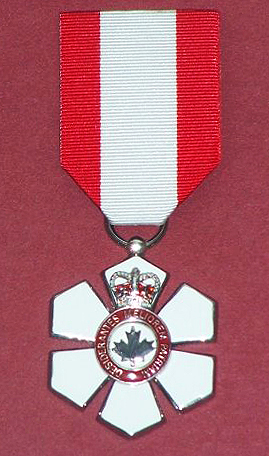
The Order of Canada is a Canadian state order and the second-highest honour for merit in the system of orders, decorations, and medals of Canada, after the Order of Merit.
The George Cross (GC) is the highest award bestowed by the British government for non-operational gallantry or gallantry not in the presence of an enemy. In the British honours system, the George Cross, since its introduction in 1940, has been equal in stature to the Victoria Cross, the highest military award for valour. It is awarded "for acts of the greatest heroism or for most conspicuous courage in circumstance of extreme danger", not in the presence of the enemy, to members of the British armed forces and to British civilians. Posthumous awards have been allowed since it was instituted. It was previously awarded to residents of Commonwealth countries, most of which have since established their own honours systems and no longer recommend British honours. It may be awarded to a person of any military rank in any service and to civilians including police, emergency services and merchant seamen. Many of the awards have been personally presented by the British monarch to recipients or, in the case of posthumous awards, to next of kin. The investitures are usually held at Buckingham Palace.
To be mentioned in dispatches describes a member of the armed forces whose name appears in an official report written by a superior officer and sent to the high command, in which their gallant or meritorious action in the face of the enemy is described.
The Cross of Valour was established in 1975 as the highest Australian Bravery Award. The awards were established as part of the institution of the Australian Honours System. The Cross of Valour has been awarded to five Australian civilians and, although there has been no Australian military recipient, they would be eligible in situations where normal honours to the military do not apply.
The orders, decorations, and medals of Canada comprise a complex system by which Canadians are honoured by the country's sovereign for actions or deeds that benefit their community or the country at large. Modelled on its British predecessor, the structure originated in the 1930s, but began to come to full fruition at the time of Canada's centennial in 1967, with the establishment of the Order of Canada, and has since grown in both size and scope to include dynastic and national orders, state, civil, and military decorations; and various campaign medals. The monarch in right of each Canadian province also issues distinct orders and medals to honour residents for work performed in just their province. The provincial honours, as with some of their national counterparts, grant the use of post-nominal letters and or supporters and other devices to be used on personal coats of arms.
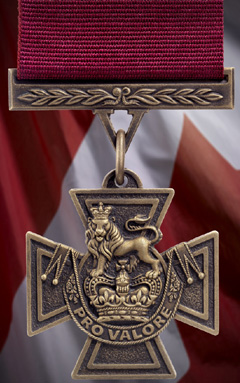
The Victoria Cross was created in 1993, perpetuating the lineage of the British Victoria Cross, while serving as the highest award within the Canadian honours system, taking precedence over all other orders, decorations, and medals. It is awarded by either the Canadian monarch or his viceregal representative, the governor general of Canada, to any member of the Canadian Armed Forces or allies serving under or with Canadian military command for extraordinary valour and devotion to duty while facing hostile forces. The British Victoria Cross was recommended prior to the creation of the Canadian medal. The previous Victoria Cross remains the highest award of the United Kingdom honours system and was also awarded in other Commonwealth countries; although most, including Canada, later established their own honours systems and no longer recommended British honours.
The following is the Canadian order of precedence for decorations and medals in the Canadian Honours System. Where applicable, post-nominal letters are indicated.
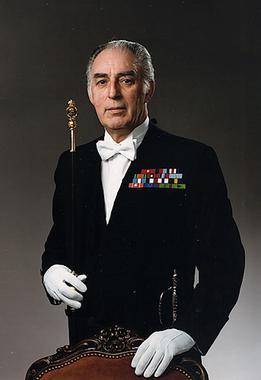
René Marc Jalbert was a retired Canadian Forces officer and sergeant-at-arms of the National Assembly of Quebec, known for his role in ending Denis Lortie's killing spree in the Parliament Building on 8 May 1984. Later he was Usher of the Black Rod for the Parliament of Canada.
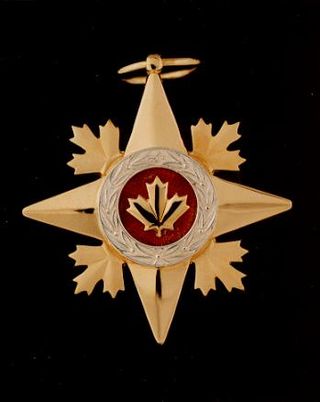
The Star of Military Valour is a military decoration that is, within the Canadian system of honours, the second highest award for military valour, and one of three honours for military valour awarded by the Canadian monarch, generally through his or her viceroy-in-Council. Created in 1993, the medal is presented to both living and deceased members of the Canadian Forces deemed to have demonstrated "distinguished and valiant service in the presence of the enemy," and grants recipients the ability to use the post-nominal letters SMV.
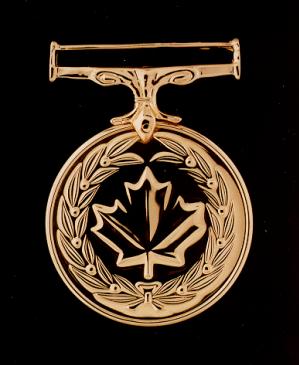
The Medal of Military Valour is a military decoration that is, within the Canadian system of honours, the third highest award for military valour, and one of three honours for military valour gifted by the Canadian monarch, generally through his or her viceroy-in-Council. Created in 1993, the medal is presented to both living and deceased members of the Canadian Forces deemed to have carried out "an act of valour or devotion to duty in the presence of the enemy," and grants recipients the ability to use the post-nominal letters MMV.

The Medal of Bravery is a decoration that is, within the Canadian system of honours, the third-highest award for bravery, and one of the three Canadian Bravery Decorations awarded by the Canadian monarch, generally through his or her viceroy-in-Council. Created in 1972, it is presented to both living and deceased individuals deemed to have performed "acts of bravery in hazardous circumstances". Recipients are allowed to use the post-nominal letters MB.

The Meritorious Service Medal is a decoration that is, within the Canadian system of honours, one of the two Meritorious Service Decorations gifted by the Canadian monarch, through the Governor-in-Council. Created in 1991, the medal is intended to recognize individuals—both Canadian and foreign—who have carried out meritorious acts bringing benefit and honour in either of two categories: military and civilian. Award of the medal grants recipients the ability to use the post-nominal letters MSM.

The Meritorious Service Cross is a decoration that is, within the Canadian system of honours, one of the two Meritorious Service Decorations gifted by the Canadian monarch, his or her Governor-in-Council. Created in 1984, the medal is intended to recognize individuals—both Canadian and foreign—who have carried out meritorious acts bringing benefit and honour in either of two categories: military and civilian.
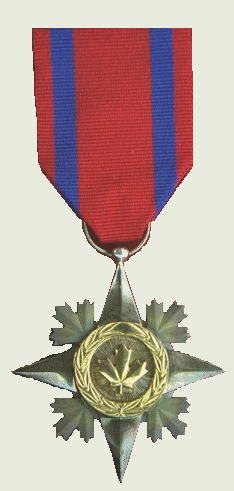
The Star of Courage is a decoration that is the second-highest award for bravery within the Canadian system of honours, and one of the three Canadian Bravery Decorations awarded by the Canadian monarch, generally through his or her viceroy-in-Council. Created in 1972, it is presented to both living and deceased individuals deemed to have performed "acts of conspicuous courage in circumstances of great peril". Recipients are allowed to use post-nominal letters – for Anglophones SC, and for Francophones ÉC.

The Order of Military Merit is a military honour for merit that is, within the Canadian system of honours, the second highest order administered by the governor in Council on behalf of the Canadian monarch.

The Victoria Cross (VC) is the highest and most prestigious decoration of the British honours system. It is awarded for valour "in the presence of the enemy" to members of the British Armed Forces and may be awarded posthumously. It was previously awarded by countries of the Commonwealth of Nations, most of which have established their own honours systems and no longer recommend British honours. It may be awarded to a person of any military rank in any service and to civilians under military command. No civilian has received the award since 1879. Since the first awards were presented by Queen Victoria in 1857, two thirds of all awards have been personally presented by the British monarch. The investitures are usually held at Buckingham Palace.

The Queen Elizabeth II Diamond Jubilee Medal or The Queen's Diamond Jubilee Medal was a commemorative medal created in 2012 to mark the 60th anniversary of Queen Elizabeth II's accession in 1952. There are four versions of the medal: one issued by the United Kingdom, another by Canada, the third for the Caribbean realms of Antigua and Barbuda, the Bahamas, Barbados, Grenada, Jamaica, Saint Kitts and Nevis, Saint Lucia, and Saint Vincent and the Grenadines, and the fourth issued by Papua New Guinea. The ribbons used with the Canadian and British versions of the medal are the same, while the ribbon of the Caribbean and the Papua New Guinean medal differ slightly. The different iterations of the medal were presented to tens of thousands of recipients throughout the Commonwealth realms in the jubilee year.
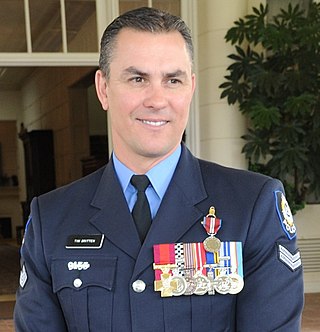
Timothy Ian Britten is a senior sergeant in the Western Australia Police. He is one of the five recipients of the Cross of Valour, Australia's highest civilian bravery decoration. He was awarded the Cross of Valour for his actions in the immediate aftermath of the 2002 Bali bombings.
The Special Honours Lists for Australia are announced by the Sovereign and Governor-General at any time.













